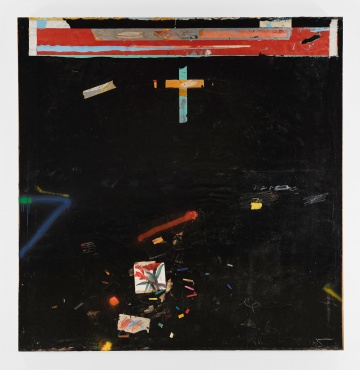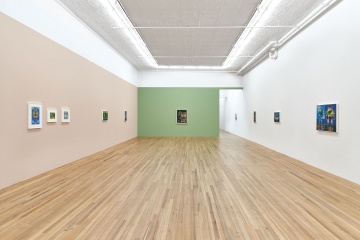Andrew Kreps Gallery
22 Cortlandt Alley
New York, NY 10013
212 741 8849
New York, NY 10013
212 741 8849
Representation of Contemporary Artists and Estates. Andrew Kreps Gallery was founded in New York in 1996. Widening its original focus on emerging American artists, the program shortly thereafter expanded to include international artists, many of whom had their first exhibitions in the United States or New York at the gallery.
Raymond Saunders
Post No Bills
February 22, 2024 - April 6, 2024
February 7, 2024 – Andrew Kreps is pleased to announce co-representation of American artist Raymond Saunders (b. 1934) with David Zwirner. A two-part solo exhibition curated by Ebony L. Haynes will open on February 22 at David Zwirner’s 519 and 525 West 19th Street galleries in Chelsea and Andrew Kreps’s gallery at 22 Cortlandt Alley in Tribeca. Titled Post No Bills, this expansive presentation will span four decades of the artist’s work. Including paintings and works on paper, many of which have never before been seen, this exhibition offers visitors insight into Saunders’s singular and influential practice.
Eileen Agar
Flowering of a Wing, Works: 1936 - 1989
January 12, 2024 - February 10, 2024
‘I have spent my whole life in revolt against convention, trying to bring colour and light and a sense of the mysterious to daily existence. One must have a hunger for new colour, new shapes, and new possibilities of discovery.’
Andrew Kreps Gallery is thrilled to announce the first major US presentation of the work of Eileen Agar (1899-1991), curated by Laura Smith, and on view at the gallery’s 22 Cortlandt Alley location from January 12 through February 10. Celebrating the central role that Agar played within the evolution of cultural languages in Europe in the twentieth century, the exhibition will include painting, collage, assemblage and photography, spanning fifty years of the artist’s remarkable career.
Agar’s abiding interest was in the synthesis of two of the twentieth century’s most significant artistic tendencies: Cubism and Surrealism. Through bringing together these two sources of inspiration she developed a unique style that offered a moving commentary on society over a period of tremendous social change. Having lived and worked through two world wars, the rise of global industrialization, the civil rights and post-colonial movements, and a ‘cold war”, Agar channelled the anxieties and tensions that such events engendered into her work – and yet she always sought a positive outlook, ever on the quest for joy. She was fascinated by classical art, ancient mythologies, the natural world and sexual pleasure, and she mined these subjects for the forms and content that filled her works, combining order and chaos and fusing vivid abstraction with figurative references.
Born in Buenos Aires, Argentina in 1899, Agar, a rebellious child, was sent to boarding school in England at the age of six. She made Europe her home, remaining on the continent until her death in London in 1991. Europe afforded Agar new freedoms and her artistic talents quickly brought her to the fore of the artistic avant-garde in London where she worked and shared ideas with Paul Nash, Gertrude Hermes and Henry Moore. And in Paris where she became associated with Surrealists such as André Breton, Max Ernst, Man Ray, Lee Miller, and Paul and Nusch Éluard, while simultaneously undertaking painting lessons with Cubist František Foltýn and famously refusing to become Pablo Picasso’s muse – instead taking him for her muse in a feminist role reversal that inspired a number of her most fêted works.
One of the few women to be included in the 1936 International Surrealist Exhibition held in London, Agar was a determined believer in artistic freedom, her own self-image and in forging her own path. In so doing she rejected canonical ideas of proportion and beauty and instead rejoiced organic forms, natural disorder and the joy of color. Coinciding with the 2024 centenary of the first Surrealist Manifesto, written by André Breton in 1924, this exhibition will highlight Agar’s distinct and spirited style, revealing her as one of the most dynamic, bold and prolific artists of her generation.
Throughout the exhibition, works from every decade of Agar’s career are presented, from her early interests in Surrealism and photography, to the impact of the Second World War, and her late blossoming with acrylic paint.
Works from two of Agar’s most significant series of work straddle the exhibition’s chronology, spanning 1936 to 1985. In 1936, following her inclusion in the International Surrealist Exhibition and wanting to escape its surrounding commotion, Agar travelled to Brittany, France landing by chance in Ploumanach after choosing to disembark from the train there when she saw ‘the fantastic rocks … like enormous prehistoric monsters sleeping on the turf above the sea: a great buttock ending in a huge thumb, or a gigantic head tuned with organ pipes, a crowd, or a foot rearing up like a dolmen, all sculpted by the sea, that master-worker of time.’ Keen to explore her belief that the surreal is formed by nature, Agar quickly realised a camera would be an artistic necessity so the following day she travelled to the nearest town and purchased a Rolliflex that would become her trusted companion for years to come. The photographs she took in Brittany of the Ploumanach rocks were to become an enduring source of influence – first as photographic works in their own right and then, years later in 1985, they influenced a series of hallucinatory rock paintings ‘based on photographs I took fifty years ago in Brittany… images so strong they imprinted themselves on my unconscious, to surface decades later as urgent themes.’ These late paintings, with their bold, dreamlike sunset pinks and blues and their post-impressionist style brushstrokes almost anthropomorphise the rocks as if she is ‘reading’ them anew. They are thus a striking expression of Agar's unique aesthetic sensibility, looking back to past lives while demonstrating a self-conscious reflection on the force of imagination.
The Second World War had enormous impact on Agar’s artistic activity, as it did for many artists of her generation, inhibiting her imagination and emotional explorations, and limiting her, and her works’ travel. Though a pacifist, she remained in London and enlisted in the war effort, volunteering in a canteen and also serving as a Fire Watcher, While remaining in London allowed Agar to keep her studio, she was little able to paint: ‘I felt it impossible to concentrate on painting when you could turn to look out of the window and see a Messerschmitt flying low over the tree tops.’ As such she turned to collage with its more political foundations. Over the next ten years Agar, still ‘aware of a sense of despondency… and threatened by morbidity’ sought to blur the divisions between collage, drawing and painting and she began to experiment with several key Surrealist techniques such as frottage, automatism, and decalcomania to pull herself out of her gloom. Some of Agar’s most striking uses of automatism, or spontaneous painting, can be found in a small selection of poured paintings from the 1940s. Here she uses oil and enamel paints to create portraits in loose outlines, fluid and liquescent drips, and swirling backgrounds. Agar enjoyed this process and the use of a new paint: ‘I like working with enamel paint because it is so free.’ Portrait, c.1949, is one of the most expressive of these ‘poured paintings’ – its twisting drips and trails are thick and tangled, marbled and puddled, with hectic overdrawing. The central figure – which could likely be Agar herself – somehow resembles an ancient Greek Tanagra ceramic. Tanagra figures were appreciated for their naturalistic and expressive features, they depicted mortal women – rather than goddesses – lightly wrapped in cloaks and silks often holding wreaths. Through this reference, Agar presents herself as earthly and human, her eyes, simple spirals, looking out of the painting with bright intent to a more hopeful future.
Other works presented reveal Agar’s ongoing acuity when combining painting, drawing and collage, for example Landscape, c.1950s and Ondine, 1972. Agar’s early collage experiments with layering, the juxtaposition of disparate forms, and the application of varying transparencies had greatly influenced her artistic style. In these two works, elements of pattern and geometrical planes are combined with deconstructed figurative features. The geometric forms in both works also grant the content clarity while Agar’s recurrent use of black balances the works. Ondine, also known as Undine, Undin or Undina, derives from the Latin word unda (wave), and is used to describe a whole host of mythological female creatures including nymphs, nereids and mermaids. The Greek myth of Ondine, actually refers to one such water spirit who became human after falling in love with a man, marrying him, and having a baby. The tale likely inspired Hans Christian Andersen’a The Little Mermaid as well as Agar’s own morphing face and fish-tail shown here.
In 1958, Agar moved into a house in West London with a large studio, here, for the first time she could paint at a scale she had never really been able to before. Another painterly discovery happened soon after when, in 1965 she was introduced to acrylic paint. She found acrylic to be ‘very versatile, it can be used as impasto, with a palette knife, or a thin wash, and gives wonderful glazes, in acrylic I had found what I considered to be an ideal medium, and I wanted to both master and stretch it.’ The large scale, acrylic paintings that she made during the 1960s and 70s are tightly composed, layered works that emulate collage but are created entirely in paint. The now characteristic Agar motifs appear – shells, birds, fossils, flowers, hands, silhouetted forms and foliage - skilfully woven into her carefully arranged canvases.
Several works presented her reveal this skill but perhaps one of the most striking is the work that grants the exhibition its title. Flowering of a Wing, 1966, deftly demonstrates Agar’s skill and dexterity with the medium of acrylic. Within the tight but harmonious composition passages of bright gradient meet blocks of opaque blacks, reds and greens, as well as geometric stripes, cross-hatching and zigzags. The large central figure – with its owl-like, heart-shaped face – seems to both peep through, and become the flower, revealing the enduring joy that Agar found in the natural world and its continual influence on her.
For the final years of her life, Agar continued to paint and draw every day and the exhibition includes a selection of her late and rarely seen felt-tip-pen-drawings in which we can still see her persistent curiosity: ‘life’s meaning is lost without the spirit of play. In play all that is lovely and soaring in the human spirit strives to find expression. To play is to yield oneself to a kind of magic. In play the mind is prepared to accept the unimagined and incredible, to enter a world where different laws apply, to be free, unfettered and divine.’ Despite her mercurial approach to making, the fundamental elements of a work by Agar endured throughout her career; the natural world, foliage, seeds, shells and watery transparencies are layered with abstracted classical figures, faces in profile and mythical symbols. All the while following the two parallel paths of abstraction and Surrealism: ‘the two movements that interested me most […] I see nothing incompatible in that, indeed we walk on two legs, and for me, one is abstract, the other Surreal – it is point and counterpoint.’ - Laura Smith

 Back to all Member Galleries
Back to all Member Galleries

